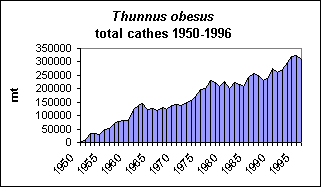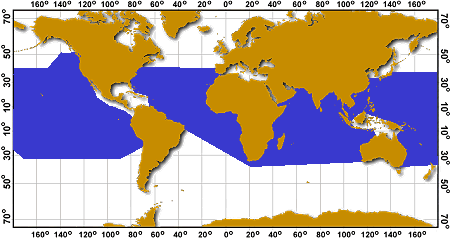
|
FAO Names |
En - Bigeye tuna; Fr - Thon obse sibi - Patudo. | ||
Size |
|
||
| Diagnostic Features |  A large species,
deepest near middle of first dorsal fin base. Gillrakers
23 to 31 on first arch. Pectoral fins moderately long (22
to 31% of fork length) in large individuals (over 110 cm
fork length), but very long (as long as in T. alalunga)
in smaller individuals (though in fish shorter than 40 cm
they may be very short).In fish longer than 30 cm,
ventral surface of liver striated. Swimbladder present.
Vertebrae 18 precaudal plus 21 caudal. Colour: lower
sides and belly whitish; a lateral iridescent blue band
runs along sides in live specimens; first dorsal fin deep
yellow, second dorsal and anal fins light yellow, finlets
bright yellow edged with black. A large species,
deepest near middle of first dorsal fin base. Gillrakers
23 to 31 on first arch. Pectoral fins moderately long (22
to 31% of fork length) in large individuals (over 110 cm
fork length), but very long (as long as in T. alalunga)
in smaller individuals (though in fish shorter than 40 cm
they may be very short).In fish longer than 30 cm,
ventral surface of liver striated. Swimbladder present.
Vertebrae 18 precaudal plus 21 caudal. Colour: lower
sides and belly whitish; a lateral iridescent blue band
runs along sides in live specimens; first dorsal fin deep
yellow, second dorsal and anal fins light yellow, finlets
bright yellow edged with black. |
||
| Geographical Distribution |  Worldwide in tropical and subtropical waters of the Atlantic, Indian and Pacific oceans, but absent from the Mediterranean. |